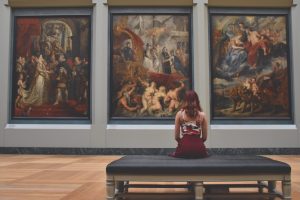
“Where it once it was embarrassing to mention art and spirit in the same sentence, today it could not be more au courant,” says art gallery curator Maurice Tuchman in the magazine Art World (January 6, 2020). Tuchman had attempted to curate an exhibit on spiritual themes in modern art in the 1986, featuring more than 100 artists exploring spiritual themes, but it “landed like a thud,” writes Eleanor Hartley. Since then, a “steady drip of rediscoveries of art with occult themes has been felt,” she adds. Such an opening for art with esoteric spiritual themes revives more than a century-old interest in modern art rejecting both materialist vision of human existence while also moving beyond “conventional representational strategies toward a radical new approach to art.” The examples of the modern revival are numerous—from a 2016 exhibition of “spirit paintings” by British artist Georgiana Houghton to the new work of selftaught and telepathic healer Emma Kunz to last year’s record-breaking attendance for Hilma af Klint’s “spirit-guided” paintings at New York’s Guggenheim Museum.
Much of this new interest is based on reinterpreting the history of modern art. Author Charlene Spretnick argues that spirituality, mysticism, and occult ideas course through the works of such modernist artists as Kandinsky, Malevich, Mondrian, Miro, Dove, and Klee. But until recently, even such an established artist as af Klint feared blowback from the art community and ordered that her Theosophy-guided works not be unveiled until 20 years after her death (and it has actually taken 40 years for these paintings to find a following). The idea of the artist as a channeler of other-worldly forces, often through the practice of theosophy and Rudolph Steiner’s anthroposophy, is especially prevalent in the new spiritual turn of modern art, writes Houghton. The reasons these once-marginal artists are moving into the spotlight may be due to the break down of the canon under pressure from multiculturalism and feminism as well as a reaction to the commodification of art. Today it is not difficult to find the equivalents to the pioneer mystic, as today’s artists openly “cop to spiritual influences on their work. Some go further, attempting to channel unconscious or even supernatural energies through drugs, hypnosis, or seances. Yet others seek portals through technology…Though none of this has yet gelled into a recognizable movement, it would seem that contemporary art and the spirit have once again made a tentative peace,” Hartley concludes.
be due to the break down of the canon under pressure from multiculturalism and feminism as well as a reaction to the commodification of art. Today it is not difficult to find the equivalents to the pioneer mystic, as today’s artists openly “cop to spiritual influences on their work. Some go further, attempting to channel unconscious or even supernatural energies through drugs, hypnosis, or seances. Yet others seek portals through technology…Though none of this has yet gelled into a recognizable movement, it would seem that contemporary art and the spirit have once again made a tentative peace,” Hartley concludes.